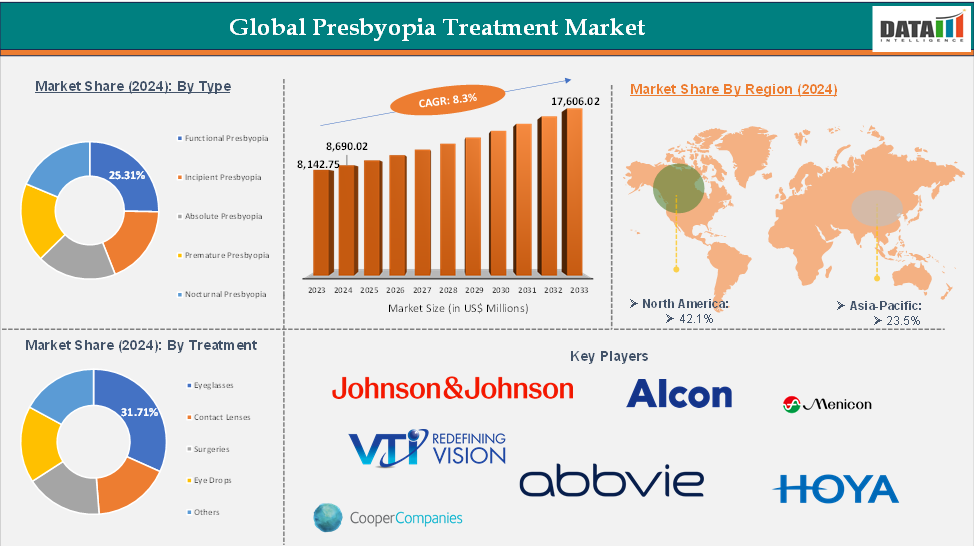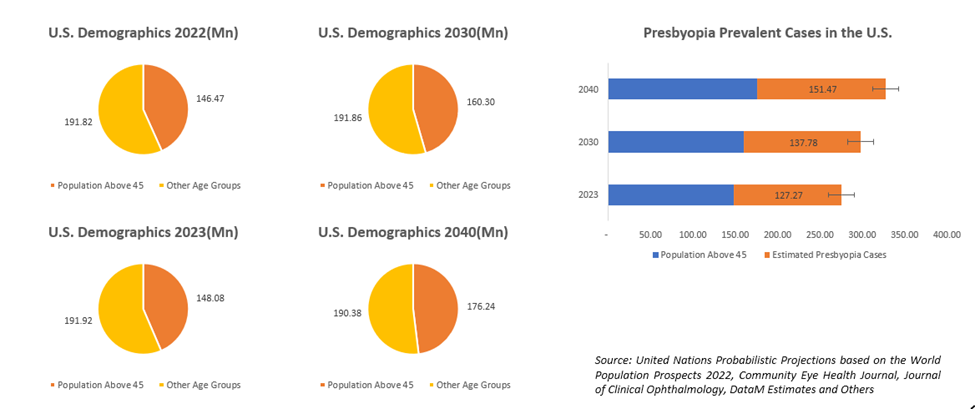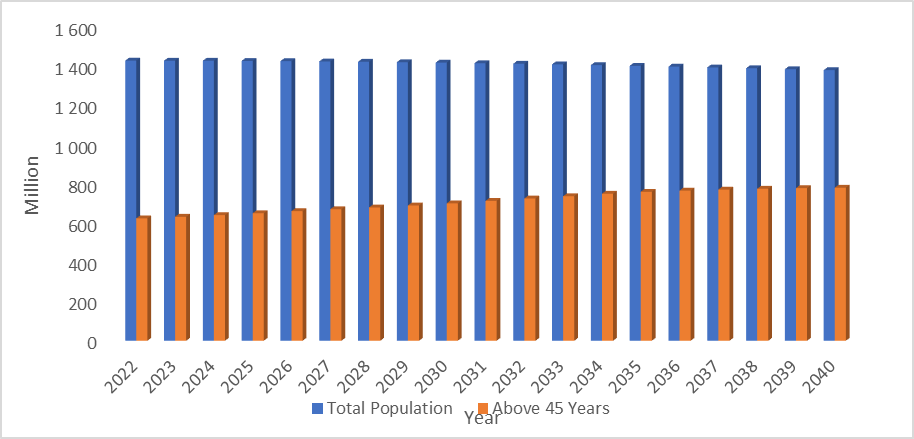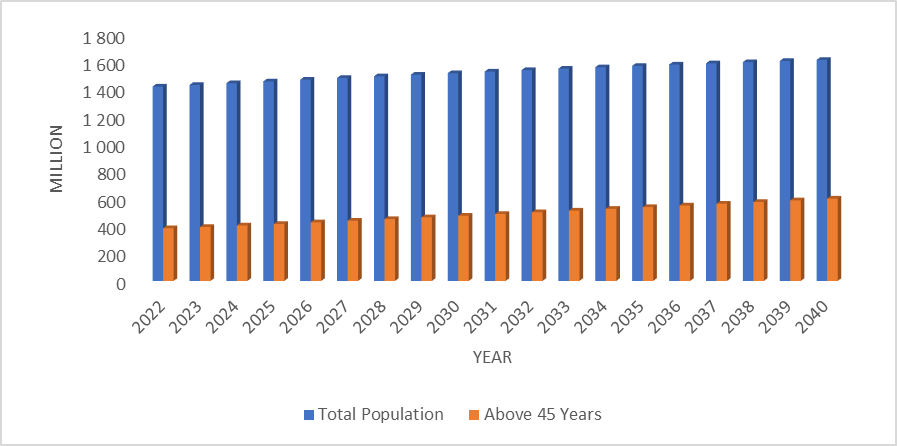Global Presbyopia Treatment Market: Industry Outlook
The global presbyopia treatment market reached US$ 8,142.75 Million in 2023, with a rise of US$ 8,690.02 Million in 2024 and is expected to reach US$ 17,606.02 Million by 2033, growing at a CAGR of 8.3% during the forecast period 2025-2033.
The global presbyopia treatment market is experiencing significant growth due to the aging population, demand for non-invasive vision correction options, and technological advancements in eye care. The prevalence of presbyopia is increasing due to longer life expectancy and sedentary lifestyles, intensifying eye strain and early symptoms. The market is expanding across both developed and emerging economies, with a preference for advanced surgical procedures like LASIK, corneal inlays, and scleral implants.
The emergence of pharmacological therapies and eye drops, such as FDA-approved pilocarpine-based solutions, is reshaping the treatment paradigm. Technological innovations like AI-assisted diagnostics and precision-based surgical tools enhance treatment efficacy and patient outcomes. However, market growth is limited by high treatment costs, limited awareness in low-income regions, and regulatory challenges. However, strategic collaborations, ongoing R&D, and increasing healthcare investments are expected to unlock substantial opportunities.
Global Presbyopia Treatment Market: Executive Summary

Global Presbyopia Treatment Market Dynamics: Drivers & Restraints
Driver: Rising prevalence of chronic diseases
The aging population is a key driver of the presbyopia treatment market globally. As the average age of the global population increases, the prevalence of age-related conditions such as presbyopia also rises, leading to increased demand for treatments.
According to the United Nations, the number of people aged 60 years and older is projected to double by 2050, reaching over 2 billion. This demographic shift is particularly pronounced in developed countries but is also significant in developing nations. The aging population is primarily driven by increased life expectancy and declining birth rates, resulting in a higher proportion of older individuals within the population.
Presbyopia typically begins to affect individuals in their early to mid-40s and becomes more pronounced with age. The condition is almost universal by the age of 50, making it a common age-related vision problem. With the aging population, the number of people experiencing presbyopia is expected to increase substantially, thereby boosting the demand for treatments.
Older adults generally have higher healthcare needs, leading to increased healthcare spending. This demographic is more likely to seek medical attention for vision problems, including presbyopia. Governments and healthcare systems in many countries are prioritizing the healthcare needs of the aging population, which includes funding for vision care and related treatments.
Innovations in presbyopia treatments, such as progressive lenses, bifocal and multifocal contact lenses, and advanced surgical options, cater to the specific needs of the aging population. The development of new pharmacological treatments, such as eye drops that temporarily restore near vision, provides non-invasive alternatives that are particularly appealing to older individuals.
Driver: Technological advancements in treatment options
Presbyopia, the age-related decline in near vision, affects nearly everyone over 40. Traditionally, bifocals and reading glasses were the only solutions. However, the landscape is rapidly changing. Technological advancements are driving the presbyopia treatment market towards a future filled with minimally invasive, personalized, and highly effective solutions.
Implantable Contact Lenses and Intraocular Phakic Presbyopic Lenses (ICLs) offer significant advantages over traditional contact lenses. Implantable lenses eliminate the need for frequent cleaning and reduce the risk of dry eyes, a common concern for contact lens wearers. ICLs function similarly to traditional contact lenses, but they are surgically implanted within the eye, offering a permanent correction for presbyopia.
Techniques like Conductive Keratoplasty (CK) and PresbyLASIK are evolving to address presbyopia with greater precision. CK uses radiofrequency energy to reshape the cornea, correcting near vision issues. PresbyLASIK, a variation of the popular LASIK procedure for myopia correction, uses laser technology to create a multi-focal corneal profile, enabling clear vision at various distances.
Restraint: High cost of advanced treatments
While technological advancements are revolutionizing the presbyopia treatment landscape, a significant challenge remains: the high cost of these advanced procedures. This financial barrier can restrict access to these potentially life-changing solutions for a large segment of the population. Advanced presbyopia treatments, such as implantable contact lenses, ICLs, and laser procedures, often involve sophisticated technology, specialized surgical expertise, and premium materials. This translates to a higher price point compared to traditional corrective methods like reading glasses or bifocals.
Detailed diagnostic evaluations using advanced equipment are often required before surgery. These tests can be expensive, especially if not fully covered by insurance. The expertise and training of ophthalmologists performing these procedures command a premium. Additionally, the use of specialized surgical facilities and equipment contributes to the overall cost.
The high cost of advanced presbyopia treatments creates a significant barrier to entry for many patients. This is particularly true in regions with limited healthcare coverage or for individuals with restricted budgets. The financial burden can deter a significant portion of the presbyopia population (estimated to affect over 1.2 billion people globally) from seeking these advanced treatments. The disparity in healthcare coverage can create an uneven playing field. Individuals with comprehensive insurance plans may have greater access to advanced treatments compared to those with limited or no coverage. On average, implantable contact lenses and ICLs can range from $3,000 to $6,000 per eye. Refractive laser procedures like Conductive Keratoplasty (CK) and PresbyLASIK can cost anywhere from $1,500 to $4,000 per eye.
Opportunity: Increasing awareness and early diagnosis
A critical factor driving growth is the rising awareness of presbyopia and the importance of early diagnosis. As people become more informed about this age-related vision condition, they are more likely to seek solutions and contribute to the market's expansion.
Traditionally, presbyopia was often viewed as an inevitable part of aging, something to be endured rather than addressed. However, this perception is changing. People are becoming increasingly aware that presbyopia is not simply "old age sight." There are a variety of effective treatment options available that can significantly improve near vision.
Early detection allows individuals to explore treatment options before their vision worsens significantly, potentially leading to better long-term outcomes and a wider range of treatment choices.
According to a 2024 survey by the American Academy of Ophthalmology revealed that 72% of respondents were aware of presbyopia, demonstrating a significant increase in public knowledge compared to previous years. Online search trends also indicate a growing interest in presbyopia, with searches for terms like "presbyopia treatment" and "presbyopia correction" steadily increasing.
Early intervention can potentially slow the progression of presbyopia and reduce the risk of associated complications, leading to a larger market for long-term vision care solutions, which is estimated to create more diagnostic product opportunities in the market.
For more details on this report, Request for Sample
Global Presbyopia Treatment Market Segment Analysis
The global presbyopia treatment market is segmented based on type, treatment, end user, and region.
Treatment Type:
The eyeglasses from the treatment type are expected to have 51.33% of the presbyopia treatment market share.
Eyeglasses with progressive lenses are the most popular solution for presbyopia for most people over age 40. These line-free multifocal lenses restore clear near vision and provide excellent vision at all distances.
It is also common for people with presbyopia to notice they are becoming more sensitive to light and glare due to aging changes in their eyes. Photochromic lenses, which darken automatically in sunlight, are a good choice for this reason.
Different eyeglasses are available for the treatment of presbyopia, like reading glasses, bifocal, trifocal, progressive lenses, and others.
Eyeglasses play a crucial role in managing this condition, offering several solutions for improved near vision. Reading glasses, available over-the-counter or by prescription, are single-vision lenses for close-up tasks like reading. Bifocal lenses have two distinct optical powers for distance and near tasks, while trifocals include a third section for intermediate vision, useful for activities like computer work. Progressive lenses, or no-line bifocals, provide a smooth transition between multiple focal points, correcting near, intermediate, and distance vision seamlessly.
Each type of eyeglass has its advantages, and the choice depends on the individual's lifestyle, visual needs, and personal preference, making consultation with an eye care professional essential to determine the most suitable option for managing presbyopia.
Global Presbyopia Treatment Market - Geographical Analysis
The North America global presbyopia treatment market was valued at 3658.5 Million in 2024
North America is well known for its advancements in the healthcare industry. Countries in the region, such as the U.S. and Canada, invest primarily in the healthcare industry and continuously create new avenues and scope for investment.
The majority of market players have established a stronghold position in North America due to its favorable market opportunities, regulatory guidelines, scope for technology advancements, and higher demand for innovative products.
Moreover, the combined population of the U.S., Canada, and Mexico accounted for approximately 507.35 million in 2023. In the same year, the U.S. population above 45 years of age accounted for 148 million, which is approximately 43.55% of the total population.
A retrospective epidemiology study published in the Journal of Clinical Ophthalmology in October 2020, nearly 83% to 88.9% of adults above 45 years of age contract presbyopia in the U.S., And As per DataM estimates, this will account for nearly 127.27 (122.91, 131.64) million presbyopia prevalent cases in 2023.
As per the data published by the American Optometry Association’s (AOA) Health Policy Institute, there are approximately 128 million presbyopic prevalent cases in the U.S. in 2023, which accounts for approximately 90% of the population above 45 years of age. As per DataM estimates, the number of prevalent cases will reach 138.38 million in 2030 and 151.57 million in 2040 in the U.S.

The Asia-Pacific global presbyopia treatment market was valued at 2042.15Million in 2024
Asia-Pacific is the most populous region in the world, accounting for nearly 4.5 billion population, which is approximately 56% of the world’s total population. In several countries across the region, such as China, Japan, and South Korea, the old age demographic is rising to peak levels, which puts them at a higher risk of developing presbyopia.
Generally, presbyopia is diagnosed at the age of 45 to 55 years, and on average, by 50 years, almost all people contract presbyopia. Asia-Pacific being the major region for old age population growth, the demand for presbyopia therapeutics is expected to rise in the forecast period, contributing to the growth of this region.
For instance, as per DataM estimates, the population (above 45 years) in China is expected to reach 700 million in 2030 and 779 million in 2040 from 623 million in 2023, growing at a compound annual growth rate of 1.25%. India, which is the most populous country in the world, has a population of nearly 384 million who are over 45 years of age, and this demographic is expected to reach 475 million in 2030 and 600 million in 2040, growing at a compound annual growth rate of 2.51%.
China

INDIA

Global Presbyopia Treatment Market – Major Players
The major players in the presbyopia treatment market include Johnson & Johnson, Alcon Inc., Menicon Co., Ltd., Visioneering Technologies, Inc., Hoya Corporation, AbbVie Inc., The Cooper Companies, Inc., Bausch & Lomb, Orasis Pharmaceuticals, Ltd, and Wenzhou Honkan Optical Company Limited, among others.
Global Presbyopia Treatment Market – Key Developments
In March 2024, Alcon launched the Clareon Family of intraocular lenses (IOLs) in India, which features Alcon’s “most advanced IOL material in its 20+ years of IOL innovation. The Clareon platform will be available in India in two presbyopia-correcting IOL technologies: the Clareon PanOptix and Clareon Vivity.
In September 2024, Entod Pharmaceuticals introduced a unique eye drop to help middle-aged individuals with presbyopia, a common age-related vision condition affecting those over 40. The eye drop could potentially replace reading glasses for those suffering from presbyopia.
Global Presbyopia Treatment Market: Scope
Metrics | Details | |
CAGR | 8.3% | |
Market Size Available for Years | 2022-2033 | |
Estimation Forecast Period | 2025-2033 | |
Revenue Units | Value (US$ Mn) | |
Segments Covered | Type | Functional Presbyopia, Incipient Presbyopia, Absolute Presbyopia, Premature Presbyopia, Nocturnal Presbyopia |
Treatment | Eyeglasses, Contact Lenses, Surgeries, Eye Drops Others | |
| End User | Hospitals, Ophthalmic Clinics, Ambulatory Surgical Centers, Others |
Regions Covered | North America, Europe, Asia-Pacific, South America, and the Middle East & Africa | |
DMI Insights:
The global presbyopia treatment market is expected to grow at an 8.3% CAGR from 2025-2033, driven by factors such as an aging global population, early vision awareness, and increased adoption of surgical and pharmacological treatments. Emerging non-invasive eye drop therapies and advanced intraocular lens technologies are expected to reshape the treatment landscape.
AI-enabled diagnostics and growing healthcare infrastructure in developing regions also present growth opportunities. However, high procedure costs and limited access in low-income areas remain significant challenges. With continuous R&D and strategic collaborations, the market is expected to expand rapidly across both developed and emerging regions over the next decade.
The global presbyopia treatment market report delivers a detailed analysis with 62 key tables, more than 57 visually impactful figures, and 205 pages of expert insights, providing a complete view of the market landscape.
Suggestions for Related Report
For more pharmaceutical-related reports, please click here

